|
我不愛說話, 因此在此發表談話我覺得很緊張, 話說三歲時父親就開始讓我與姐姐們一起學鋼琴 那便是我的音樂教育之初始. 學鋼琴培養了我的音感, 八歲時學了古箏, 那是培養了我的手感, 手與弦之間的感覺. 但因大學升學壓力, 我兩者都放棄了, 直到二十年後來美認識了袁中平先生, 開啟了我的古琴生涯. 我大學唸的是實踐家專服裝設計, 在台灣的服裝界工作了五年後來到紐約 進修服裝商品管理. 後又在紐約服裝界工作了七年. 接觸了古琴之後越發覺得與我所從事的行業越來越多衝突. 那衝突是思想上的, 覺得每日汲汲營營為消費成衣忙碌, 忙的是什麼? 忙的是讓大家昨天穿過的衣服今天就不想穿了, 隨時要換一件新的衣服. 我對外在的越來越不在乎, 而對內在的越來越在乎. 於是便把工作辭了專心學習與研究古琴. 以前的我不愛讀書, 因為古琴, 我開始讀書, 開始看畫, 看有古琴的畫, 讀有古琴的書. 哲學思想上也開始接觸與古琴相關的儒道佛思想, 特別對道家天人合一 對大自然與人之間的關係, 對中醫, 四時, 氣, 與人體的關係, 對太極拳, 對靜心禪坐都產生了極大的興趣. 並會思考如何將這些道理運用在彈奏古琴上. 還記得前些日子我與先生的身體都出了些小狀況, 我們的心臟科醫師介紹一位氣功導師給我們, 同時也參加了在家附近的一個丹瑜珈的課程, 學習到如何調整自己的呼吸以及何謂氣守丹田, 而我真正體會到氣守丹田是在稍後一次郊外騎腳踏車. 我已經很久沒騎腳踏車了, 那天我們租了兩台腳踏車, 我一上去就一直擔心會跌倒, 龍頭把的很不穩. 突然就有這個念頭, 試試氣守丹田吧~ 我把意念放在丹田上, 頓時覺得我的重心從我的腦轉移到腹部, 雙手放鬆了許多, 腳踏車的龍頭不再扭來扭去, 那天玩的非常愉快. 事後我便一直記著這個體會, 並常常運用在彈古琴的調氣訓練上, 發現我的手指更靈活了. 兩年前我開始學大提琴, 一是大提琴是我最喜歡的西洋樂器, 二是想再把西樂理搞好以便'當我的古琴與不同樂器合奏時能有所依據, 畢竟西樂強調節拍. 古琴與其他樂器合奏時, 有個依據再來培養默契會比較容易, 除非都是玩即興. 我曾與尺八, 古箏, 復古箜篌, 合奏過都還是要先有個共同樂譜來幫助. 學了十年的古琴再來學大提琴一開始我很難把大提琴的節拍抓準, 總是覺得為什麼我不能把這個音拉長一點, 但是就是不行. 它們的理由還是在於要配合其它樂器. 大提琴老師說拉弓時不能讓人感覺到你在變換弓, 我就會把這樣的理念用到古琴上, 會去思考如何在運指間不著痕跡, 如何不讓氣頓, 搞創作時也會因此而思考如何決定指法與運指.
最後我說彈古琴能讓我繼續不斷地訓練左右腦的協調以防老人癡呆症. 全場觀眾便笑了出來. 發表談話的還有王妙蓮女士與戴得先生(見下面第三張照片), 妙蓮也大致說了她學琴的過程. 戴德則很用心地把他的中文槁拿出來讀了一遍為什麼他會做電子古琴. 最後從法國來的周璇捷小姐(見下面第四張照片)說了她曾在二零零五年在海外發表過的她的將古琴與電腦結合的給兒童認識古琴的一個軟體遊戲, 非常有意思. 周璇捷小姐剛好今年下半年到明年上半年在台南藝術大學做客座副教授, 她最希望這一年內能在台灣學會彈古琴與製作古琴. 她曾在北京請田雙崑大師為他啟斲了兩床她自己設計的古琴並自己完成了漆工的部份. 其中一床她自己命名為半混沌琴(見下面第二張照片振亞兄身旁的那床琴)有在坐談會上展示給大家看. 晚上的古琴表演, 現場坐滿了觀眾. 培幼首先彈了石上流泉, 接著彈了瀟湘水雲, 最後收回激動的心情彈了漁橋問答. 戴德彈了秋塞吟與烏夜啼, 然後彈了他的創作曲河水是用他的電子古琴搭配合成音樂. 此時因為妙蓮覺得電子古琴太大聲就改站到房間的最後面. 王妙蓮彈了古琴吟, 良宵引, 以及平沙落雁. 最後袁中平先生彈了離騷與彈唱了他為姜夔的長亭怨慢譜的古琴曲, 結束今晚的表演. Oct 1st 2pm – 4pm there was a conference, 6pm – 8pm there was a guqin concert. Both were in the same room as the previous night. I dressed up in the traditional Chinese style costume I made. Before the previous night, I did not know that I needed to give a talk at the conference until during the last night dinner, Mr. Yuan and Jerome told me so. I had to think what I could say, so I spent the night thinking about it and wrote down the brief points that I could say. The next afternoon, I talked about how the Guqin influences my life. Here is what I said... I am a quiet person, so I feel a little nervous about giving a talk here. When I was 3 years old, my father had his daughters learn piano and there began my musical education. When I was 8 years old, I learned Guzheng. Learning piano helped my sense of music. Learning Guzheng helped my sense of the relationship between fingers and strings. However I gave up both piano and Guzheng while under the pressure of entering college. 20 years later I met Mr. Yuan Jung-ping in New York and started my guqin life since then till now. I studied fashion design in Shi-jian Home Economic College and worked in the fashion industry in Taiwan for 5 years. Then I moved to New York to study Fashion Merchandise Management and worked in the fashion industry in NY for 7 years. Since I began studying the Guqin, I had more and more Ideological conflicts with my fashion career. I was getting confused about why I worked so hard to just to satisfy people's material desires that they don't want to wear the same clothes everyday, that they have to chase the fashion trend? I was more and more uninterested in “outside” and more and more interested in “inside”. Therefore, I quit my job and now fully concentrate on my guqin study. When I was young, I did not like to study. Because of the Guqin, I started to read, started to pay attention to Chinese painting. I read books about guqin, I look at paintings that have guqin in it. I pay attention to the philosophy that is related to guqin, the Confucianism, Taoism and Buddhism, especially the idea from Taoism that the great nature and human being are as one. I am more concerned about the relationships of those, such as Chinese medicine, four seasons, qi (energy), Taiji, meditation etc, to our body; and how they can be related to Guqin playing. Several months ago, my heart doctor introduced a Qigong master to me and my husband. We also took some lessons of Dahn yoga. Since then, I learned how to concentrate on breathing and keep the energy in our Dantian area. There was this one time I experienced something that enlightened me. We were riding on bicycles in the country side. Since I had not ridden on a bicycle for a long long time, I had trouble balancing myself. Finally I thought about trying to concentrate my energy on Dantian, and suddenly I felt that my weight was shifted from head to lower belly and my arms are much more relaxed and so I was more balanced on my bicycle. Since then, I have remembered this experience and when I play guqin, I think of this experience and it helps my fingers to be more flexible and my arms much more relaxed. Two years ago, I started to learn cello. Cello is my favorite western musical instrument. Also I wanted to keep learning western music theory. Western music has more emphasis on rhythm and that is important for playing ensemble. I had played guqin ensemble with shakuhachi (bamboo flute), guzheng (zither) and traditional Kong-ho (harp), etc,. Using the western music notation is a good way for each instrument to follow at the beginning then to foster understanding later. I've been playing guqin for 10 years, so it was a little difficult for me to start to play cello at the beginning, since I had trouble to keep the rhythm correct . I would wonder why I couldn't keep one note longer as I want. My teacher always corrected me on that and said that I need to think about if I play with other instruments together. My cello teacher once said that when playing cello, you need to let listeners not to recognize that you are changing bow. I will use this idea onto guqin playing and will think how to make my fingering more smooth and how to move one note to the other smoothly; how to keep my energy smooth, and how to decide the fingering when I compose a new piece. Finally, I said that playing the guqin will help me to train the coordination of my left and right brain to prevent Alzheimer's disease. The audience then laugh out. During the conference, Marilyn also talked about her qin learning history. Stephen Dydo carefully read his note in Chinese about why he made the electric guqin. (Please see the 3rd photo below). Later Shuengit from Paris (please see the 4th photo below), who was invited to show the "Half Hundun" by Stephan Dydo and "Pale Ink" by Jerome. She talked and demonstrated the "Pale Ink" that she had published abroad in year 2005. The "Pale Ink" is that Shuengit combined guqin and computer technology and made a software of guqin game for children to know what guqin is. It is a very interesting program. Shuengit was invited by Tainan University of Art to be a Visiting Associate Professor for one year from Fall 2011 to 2012. She hopes that she can learn how to play guqin and how to make guqin during this year in Tainan. She had met a qin maker Mr. Tian Shuang-kun in Beijin and Mr. Tian helped her to make two guqin that she designed and finished the lacquer work by herself. In the conference, she showed the audience one of her qin which she called it “Half Hun Dun Qin.” (Please see the 2nd photo below that has the half hun dun qin next to Jerome).
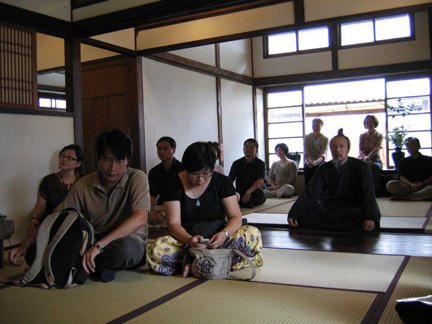 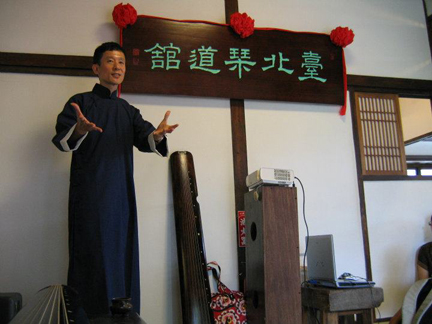 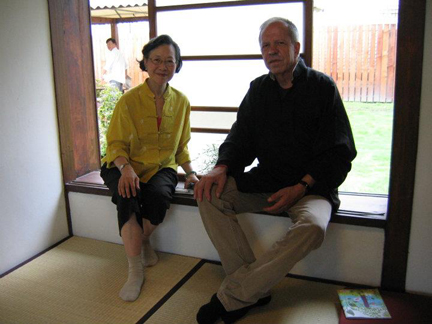 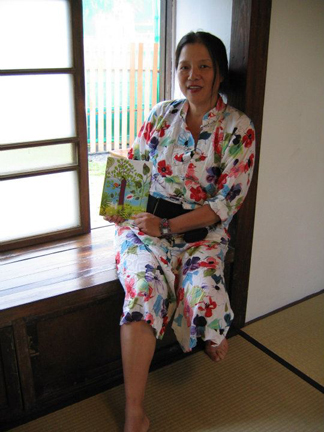 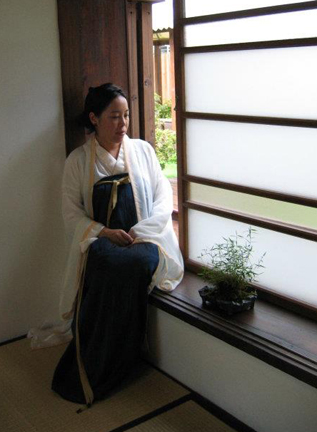 古琴回家(第一天)Guqin Return Home (The 1st Day) | ||
Back To Main Menu | ||